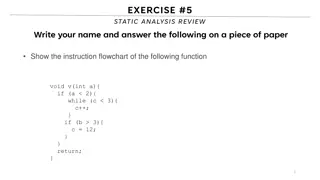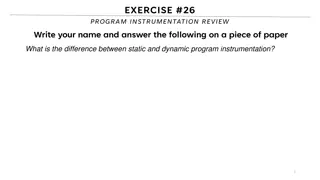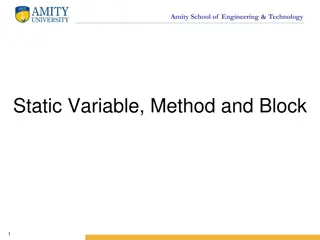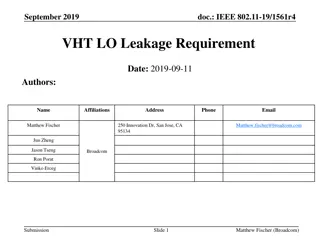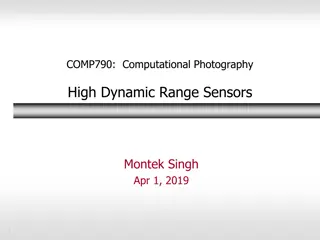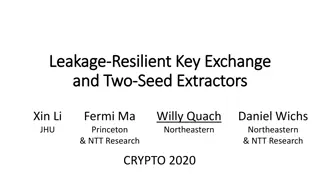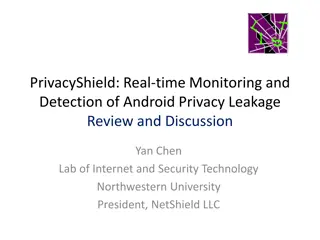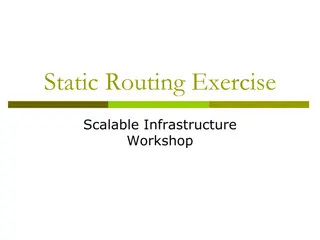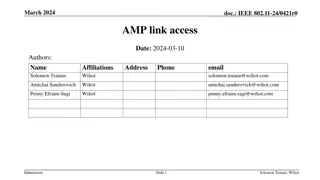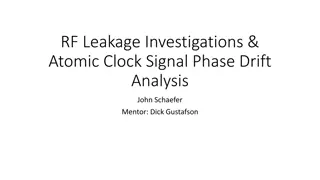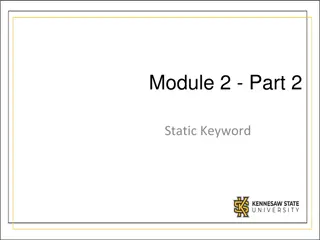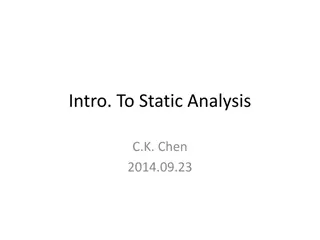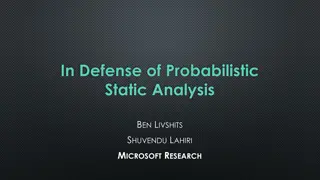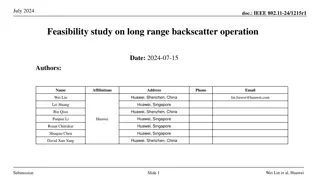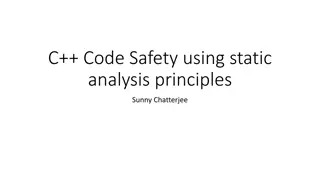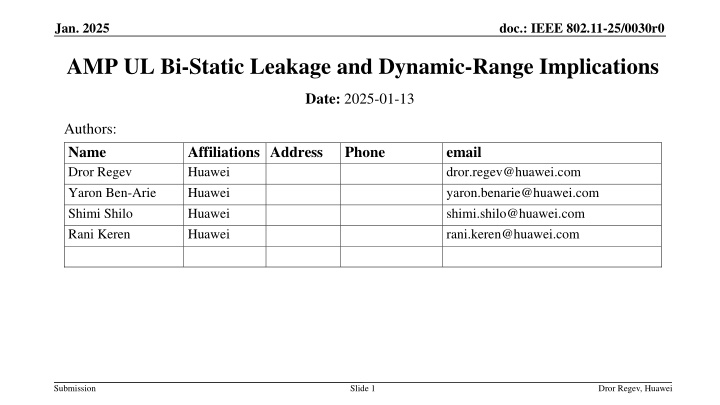
Implications of Bi-Static Leakage on AMP Uplink Performance
Analyzing the impact of direct carrier leakage on dynamic range in a Bi-Static scenario for AMP Uplink performance. Discussing leakage mitigation, limitations on Uplink range, and factors affecting backscattering. Exploration of UL SNRs, path loss, and signal levels in the context of IEEE 802.11 standards.
Download Presentation

Please find below an Image/Link to download the presentation.
The content on the website is provided AS IS for your information and personal use only. It may not be sold, licensed, or shared on other websites without obtaining consent from the author. If you encounter any issues during the download, it is possible that the publisher has removed the file from their server.
You are allowed to download the files provided on this website for personal or commercial use, subject to the condition that they are used lawfully. All files are the property of their respective owners.
The content on the website is provided AS IS for your information and personal use only. It may not be sold, licensed, or shared on other websites without obtaining consent from the author.
E N D
Presentation Transcript
Jan. 2025 doc.: IEEE 802.11-25/0030r0 AMP UL Bi-Static Leakage and Dynamic-Range Implications Date: 2025-01-13 Authors: Name Dror Regev Yaron Ben-Arie Shimi Shilo Rani Keren Affiliations Address Huawei Huawei Huawei Huawei Phone email dror.regev@huawei.com yaron.benarie@huawei.com shimi.shilo@huawei.com rani.keren@huawei.com Submission Slide 1 Dror Regev, Huawei
Jan. 2025 doc.: IEEE 802.11-25/0030r0 Abstract Backscattering Uplink AMP performance in a Bi-Static scenario is analyzed and the direct carrier leakage effects on instantaneous dynamic range are considered, showing the limitations imposed on UL range. Here we show that whereas leakage mitigation may be used in some scenarios (e.g. [4] and [5]), there are many other scenarios and use cases where leakage mitigation is not required. Submission Slide 2 Dror Regev, Huawei
Jan. 2025 doc.: IEEE 802.11-25/0030r0 Background: AMP Bi-Static Backscattering PT Carrier power transmitted PBS- Power Backscattered PRX - Power received at the reader PLk - Power leaked at the reader Tn Tag n Backscattering Uplink transmitted power by backscatter STAs (PBS), depends on the EIRP of the carrier source, the path loss from it to the tag and the backscattering loss. The desired AMP STA UL power PRX arriving at the AP (reader) antenna, depends on the path loss from the tag to the AP. An undesired direct leakage of the carrier signal of a magnitude PLk appears simultaneously at the AP with desired signal PRX and acts as a blocker. AP PRX1 PLk DB1 BS Loss 1 PBS1 PRX2 T1 DLk DA1 DB2 BS Loss Factors: Modulation Design Frequency Tag orientation Object Absorption PT DA2 Carrier Source BS Loss 2 PBS2 T2 Submission Slide 3 Dror Regev, Huawei
Jan. 2025 doc.: IEEE 802.11-25/0030r0 2.4 GHz Mono-Static Backscattering [1], [2] [1] [2] Leakage signal: 0dBr WiFi AMP reader AMP tag BS signal level: e.g. -30dBr Can we follow a similar approach with Bi-Static BS? Rx noise floor: e.g. -45dBr Submission Slide 4 Dror Regev, Huawei
Jan. 2025 doc.: IEEE 802.11-25/0030r0 Background: 2.4 GHz Uplink Backscattering [3] In [3], the UL SNRs with no carrier direct leakage were treated. Link Assumptions Carrier Source EIRP Backscattering Loss Reader NF Reader minimum SNR PT Carrier power transmitted PBS- Power Backscattered PRX - Power received at the reader * 20dBm for < 10MHz BW in the US 20 dBm 5 dB 9 dB 3 dB AP DB2 BS Loss - without a mixer for frequency shifting PRX1 DB1 FRIIS & SNRUL [dB] BW DA, DB [m] PBS [dBm]PRX [dBm] 4, 8 10, 10 8, 4 DB3 Backscattering Loss 1 MHz SNR 10 0 10 2 MHz SNR 7 -3 7 PEH [dBm] for Harvesting -32 -40 -38 DA2 PBS1 DA3 -37 -45 -43 -95 -105 -95 DA1 BS Loss Factors: Modulation Design Frequency Tag orientation Object Absorption PT Carrier With no direct leakage, the UL range exceeds 5 meter and is limited by the EH range (assuming -34 dBm EH sensitivity threshold) Submission Slide 5 Dror Regev, Huawei
Jan. 2025 doc.: IEEE 802.11-25/0030r0 2.4 GHz Bistatic Uplink Accounting for Direct Leakage Link Assumptions Carrier Source EIRP Backscattering Loss Reader Effective DR Reader min SNR 20 dBm 5 dB 50 dB 3 dB DR- Dynamic Range DR in practical AMP BS with a direct leakage is not limited by the noise floor FRIIS & SNR [dB] DA, DB, DLk [m] 0.7, 0.7, 1 1, 1, 1.4 1, 5, 5 1.4, 5, 5 1.4, 1.4, 2 2, 2, 3.1 4, 4, 4 Uplink range is degraded significantly by the direct leakage PBS [dBm] -22 -25 -25 -28 -28 -31 -37 PRX [dBm] -59 -65 -79 -82 -71 -77 -89 PLk [dBm] -20 -23 -34 -34 -26 -30 -32 PLk -PRX [dB] 39 42 45 48 45 47 57 SNR[dB] 11 8 5 2 5 3 -7 PEH [dBm] -17 -20 -20 -23 -23 -26 -32 Submission Slide 6 Dror Regev, Huawei
Jan. 2025 doc.: IEEE 802.11-25/0030r0 Revisit 2.4 GHz Mono-Static Backscattering Leakage signal: 0dBr Example : AP DR= 50 dB, AMP tag BS Loss 5 dB 20 cm /-26 dB PEH = -26 dBm AP WiFi AMP reader AMP tag 0 dBm Dynamic Range Self Leakage 20dB BS Loss BS signal: -37dBr SNR PLk -20 dBm PRX -57 dBm Rx noise floor: e.g. -50dBr PLk -PRX = 37 dB SNR= 13 dB Uplink range is limited by PEH Submission Slide 7 Dror Regev, Huawei
Jan. 2025 doc.: IEEE 802.11-25/0030r0 Discussion: The direct leakage blocker in bi-static backscattering, imposes a DR limitation similar to the self leakage in mono-static backscattering The bi-static blocker degrades passive BS range to about 2 meters, or more if the tag is within 1 meter from the carrier source Bi-static BS can be treated as an extension of the EH and UL ranges of mono-static BS. A simple use case example, maybe a smart shopping cart that enables both mono-static and bi-static BS Submission Slide 8 Slide 8 Dror Regev, Huawei
Jan. 2025 doc.: IEEE 802.11-25/0030r0 Summary In principle we can adopt the BS mono-static UL analysis for bi-static operation. The BS range is limited by the direct carrier leakage/blocker and dictated by the AP DR performance UL range of about 2 meter, may still be achieved when direct leakage is present for an DR of 50 dB with EH power levels that are relatively sufficient Hence such simple fully passive backscattering devices will be able to charge/recharge and communicate relatively frequently and efficiently to short ranges as compared with semi-active BS tags [4], or active tags with extended ranges that dissipate more power while harvesting at much lower levels Submission Slide 9 Slide 9 Dror Regev, Huawei
Jan. 2025 doc.: IEEE 802.11-25/0030r0 References 1. 11-24-0798r0 Close-range AMP WiFi Reader Feasibility Study Follow up ; Rui Cao (NXP) 2. 11-24-0537r0 Close-range AMP WiFi Reader Feasibility Study ; Rui Cao (NXP) 3. 11-24-1786r0 Tradeoffs - Active and Backscattering AMP Tags ; Dror Regev (Huawei) 4. 11-24-1687r0 Frequency Shifting in Backscatter Operations ; Nelson Costa (Haila) 5. 11-24-1543r0 Frequency translation backscatter ; Manideep Dunna (Qualcomm) Submission Slide 10 Slide 10 Dror Regev, Huawei


